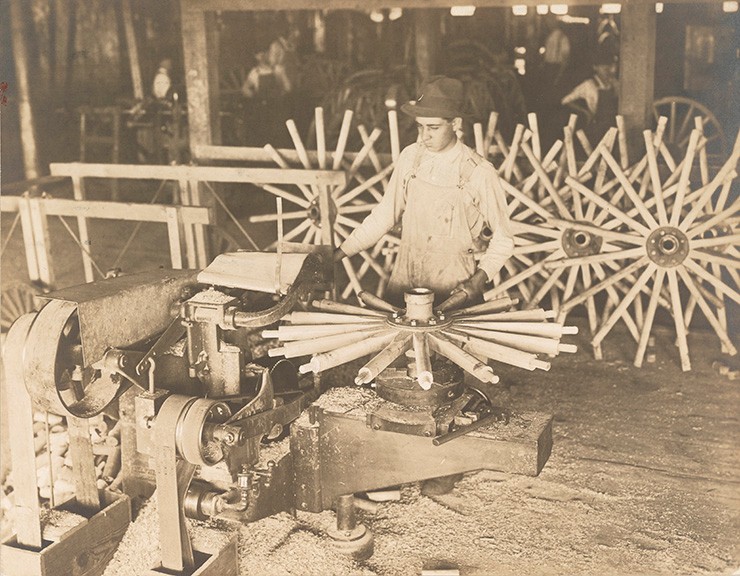Piedmont Wagon Company
Introduction
Text-to-speech Audio
Images
Front of the sole surviving Piedmont Wagon Company building
%20cropped-400x274.jpg)
The making of wagon wheels (October 8th, 1918)

Backstory and Context
Text-to-speech Audio
In 1878, George C. Bonniwell (1837-1912), a New York native who moved to Hickory in the 1870s, and Andrew (Andy) L. Ramseur (1817-1906) founded the Piedmont Wagon Company on the outskirts of Hickory. The wagon company was one of the first major industries in the town that would help establish Hickory as a major trading center. By 1880, the company relocated to have easier access to the railroad and was incorporated two years later. The company began with $20,000 in capital stock, and would eventually consist of thirteen buildings.
The company employed over 100 workers and could produce 1,000 wagons per month, making it one of the county's most efficient wagon producers. The division of labor at the factory was reflected in the constituent parts of the plant--the lumber yard, Blacksmith shop paint shop, bed department, and shipping department--and the company hired skilled workers and general laborers.
Neither of the founders stayed with the company for long. Ramseur, who was sixty-two years old in 1880, returned to operating his mills and forge at Horseford Shoals. George Bonniwell left the Wagon Company and founded the Hickory Cooperative Association in 1881, which was later known as the Hickory Manufacturing Company, a woodworking plant which made sashes, doors, blinds, inside trim, and other building material. George Harvey Geitner operated as the superintendent of the business until 1918, even though the company was sold to New York investors and renamed the Piedmont Wagon and Manufacturing Co. in 1910.
During World War I, the company entered into a contract with the French government to supply 1,000 ammunition wagons within sixty days that each weighed 1,400 pounds and required three horses to pull, which was a modified version of their typical 800 pound model that could be pulled by two horses. This contract was reportedly worth $130,000, which, when accounting for inflation, is $3.2 million today. In 1917, the company established a second government contract with the United States to supply wagons for the soldiers.
The company traded hands again in 1924, when Daniel E. Rhyne, a benefactor of Lenoir-Rhyne College, purchased it for $300,000. However, after Rhyne purchased the company, he had to face tax controversy and a lawsuit because the previous owners failed to pay taxes from 1917-1919. The company was represented in court by Marion Butler, a former United States senator, and their defense was that Daniel Rhyne's nephew, Preston Rhyne, who was the company's secretary and treasurer during the time in question, was just a country boy ignorant of corporations and the law. This would not be the only time that the company faced tax issues, however. As the firm was sold to Henry Leonard in the 1940s and production halted with the rise of the automobile industry, tax liens were placed on the property beginning in 1948 for failure to pay taxes from 1943-1947, resulting in the folding of the business. A fire in 1958 destroyed all but the 2 1/2-story "L" shaped building that still stands today, which had a brick firewall constructed around it to prevent fire damage and was auctioned in 1958. The Hickory Development Corporation bought the property for $60,000 with the intention of using it for new industrial and business sites. In 2015, the Cornerstone United Inc., a company providing warranty solutions, renovated the building for office space.
The building was added to the National Register of Historic Places on March 15th, 1985, for its association to the Piedmont Wagon Company, which helped establish Hickory as one of the dominant trading centers of the late-nineteenth to mid-twentieth centuries.
Sources
About Us, Cornerstone United. Accessed December 13th 2019. https://www.cornerstoneunited.com/english/about.html.
Bandel, Jessica A. Piedmont Wagon Company Keeps Army Rolling, NC Department of Natural and Cultural Resources. August 17th 2017. Accessed December 13th 2019. https://www.ncdcr.gov/blog/2017/08/17/piedmont-wagon-company-keeps-army-rolling.
https://www.charlotteobserver.com/news/local/community/gaston-catawba/article9258761.html.
Hahn, George W. The Catawba Solider of the Civil War. Hickory, NC. Clay Printing Company, 1911.
Phillips, Laura A. W. Piedmont Wagon Company, National Register of Historic Places. March 15th 1985. Accessed December 13th 2019. https://files.nc.gov/ncdcr/nr/CT0183.pdf.
Piedmont Wagon Company, Western Piedmont Museum of Labor & Industrial History. Accessed December 13th 2019. https://workinginthefoothills.weebly.com/piedmont-wagon.html.
Williams, Wiley J. Piedmont Wagon Company, NCPedia. Accessed December 13th 2019. https://www.ncpedia.org/piedmont-wagon-company.
Canrobert, Mary. Piedmont Wagon Building Begins New Life, The Charlotte Observer. January 17th 2015. Accessed December 13th 2019.
https://www.hickorync.gov/content/west-hickorywestmont-neighborhood-association-0
https://www.ncdcr.gov/blog/2017/08/17/piedmont-wagon-company-keeps-army-rolling
